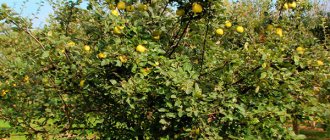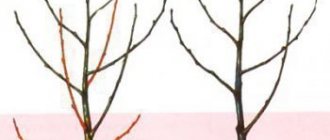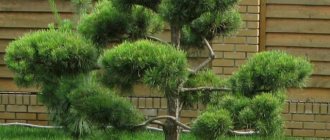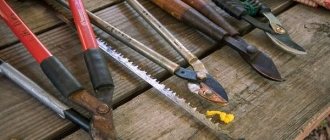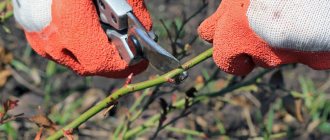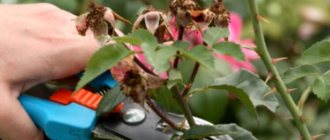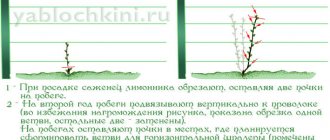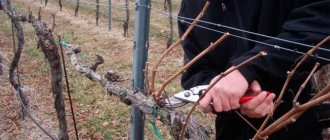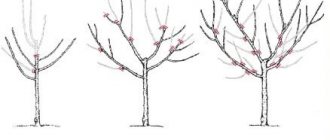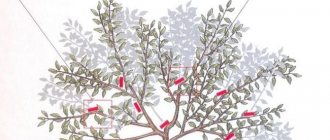Why prune an apple tree in the fall?
In order for apple trees to produce a good harvest, they need to be properly cared for. Proper care includes pruning apple trees in the fall. Purpose of the procedure:
- keep the tree healthy;
- rejuvenate;
- ensure longevity;
- increase productivity;
- improve air access to the branches:
- form a crown.
Schemes for the formation of old apple trees
The pattern for pruning old apple trees in the fall depends on the shape of the crown. It is determined by the type of rootstock (clonal semi-dwarf, seed), characteristics of the variety, and climate. The original nature of the apple tree corresponds to a sparsely tiered crown shape; it is used when growing medium- and vigorous-growing varieties.
Low-growing varieties are formed in the shape of a bowl. In the conditions of Siberia, European varieties of apple trees with low winter hardiness are grown in the stylata and stylata-bush forms. The crown of columnar apple trees is similar to cypress; to maintain fruiting, it requires minimal but annual pruning.
What you need to prepare
It is necessary to carry out preparatory work: purchase garden varnish for treating wounds, tools:
- Secateurs. Remove shoots up to 2 cm thick.
- Hand hacksaw. Trim thick branches.
- Garden knife. Trim the bark on cuts.
- The stairs.
Instruments are disinfected and performance monitored.
Assess the amount of work, pay attention to the condition of the apple trees:
- development;
- crown size;
- age of trees;
- condition of the wood.
Types of pruning
Pruning is divided according to purpose:
- Sanitary . Carry out regardless of the season. Improves the appearance of wood. Clears the crown of diseased, dry, broken branches, tops, and corrects previously made incorrect cuts.
- Forming . Forms the crown of young seedlings.
- Structural . Corrects the structure of the tree. Thins out the crown. Removes branches that touch others, cross with them, rub, thicken the crown, grow vertically, at an acute angle or interfere with the growth of neighboring trees, or injure the trunk.
- Rejuvenating . Ensures the growth of young shoots on old trees.
During autumn pruning, more than 40% of the shoots are not removed. The tree may weaken and not survive the winter.
Apple tree rejuvenation
Rejuvenating pruning should only be done on old trees over 20 years old. Before starting this procedure, you should make sure that the trunk is completely viable and the main branches are not affected by all sorts of diseases and rot. The crown should be divided into zones. Her rejuvenation is carried out over several years. One zone is pruned in one season. This will give the tree time to recover after a rather traumatic operation.
Branches should be cut according to the following rules::
- In the first year, removal is carried out on the south side.
- Next year, cut off the branches from the second side. New shoots that have managed to form during the season on the first side are also pruned. Only shoots growing vertically are removed.
You need to cut off all branches that grow inward and vertically. Dry, diseased, and those that do not bear fruit are also removed. This promotes crown advancement. It should be remembered that during rejuvenation, the best solution would be to cut off one large branch rather than many small ones.
Next, the center of the crown is revealed:
- The trunk is shortened. This must be done at a height of 3 m from the trunk.
- Remove branches growing above young shoots.
- Everything that grows in the center is cut off. About 10 branches are left, directed from the center.
Important!
After this procedure, next year new shoots will begin to appear, the number of leaves will increase, and the supply of necessary nutrients will improve. It should be remembered that rejuvenation should be performed once every 5 years.
Methods for autumn pruning of apple trees
There are two ways to prune an apple tree:
- thinning (removal of branches);
- shortening (changing the length of a branch).
Shortening
The method affects the development of the tree, as does thinning. The branches are not completely removed; their ends are cut off.
The advantages of shortened shoots over non-shortened ones: thickness increases, branching improves, buds are better formed.
Thinning
Thinning improves access to branches of air and sunlight - the crown is better illuminated. This protects against diseases and increases the productivity of apple trees. The cuts are made “on the ring”, at the same level as the trunk. Do not leave stumps or cut branches too deep. A long stump will rot and a hollow will form, which will lead to the death of the tree.
Trimming degree
Beginners should know that shortened branches increase the yield of apple trees. The amount of shortening is of three types, depending on the age of the trees:
- Weak . Fruit-bearing shoots form on young apple trees. Cut off a quarter of the branch. Young shoots grow from the last buds the next year. The growth of branches on the cut part increases.
- Average . Cut off a third of the branch. Designed to increase the number of fruiting shoots of 5-year-old plants and rejuvenate old apple trees.
- Strong . Used for crown thinning and better ventilation. The branches are cut in half.
Dry branches should not be sawed down to the ground. A hollow is formed at the site of the cut. The apple tree may die. The saw cut is treated with garden varnish.
The age of an apple tree is determined by its appearance. The height of annual trees is 100–120 cm, there are no side shoots. Two-year-old trees are taller than 120 cm, have side shoots, and do not have apples.
How to prune an apple tree in the fall: step-by-step tips for beginners
The apple tree is pruned from the first year throughout its life. Fall pruning prepares trees for winter. Processing sequence:
- Remove dry and broken branches. Leave the stump until the first bud. The branch is not removed to the base, otherwise a hollow will form on the cut over time.
- Rotten, diseased, pest-affected shoots are cut off: thin ones with pruning shears, thick ones with a hacksaw.
- Thin out the crown. Living branches are removed “in a ring”; no stumps are left.
- The remaining branches are shortened.
- Cut branches are removed from the site and destroyed.
Cuttings of more than two centimeters are treated with garden varnish. Sawed and cut branches are immediately removed from under the trees; they may harbor pests.
Using a hacksaw, they begin to saw from the underside of the branch, having cut through a few centimeters, continue working in the upper part.
Structural and formative pruning is done simultaneously in the fall. If there are a large number of cut branches, formative pruning is postponed until spring.
Step-by-step pruning in autumn in pictures
Treatment of cuts and wounds
Wounds with smooth edges heal quickly, so you need to use a well-sharpened tool. Sections of old dry branches are processed immediately, fresh shoots - a day after pruning. Wounds larger than 7mm are treated as follows:
- disinfected with copper sulfate and lime 1:10;
- coated with garden varnish or oil paint on drying oil.
Annual branches
A cut in annual branches is made above a developed bud. The stump must be at the level of the kidney (Fig. 1).
You cannot make a stump over the kidney - the wound will take a long time to heal (Fig. 2). The stump under the bud (Fig. 3) will die over time.
The main thing in processing annual plants is to form a crown.
When do you need a haircut?
All apple trees need autumn pruning. The procedure can be postponed until spring, but in this case you may not be able to complete it within the recommended time frame. Additionally, there is a risk of return frosts.
Haircuts in autumn are best for beginners. There is no need to rush anywhere after summer. To make the process easier, you can use a video for beginners.
The specific timing of the procedure is selected depending on weather conditions. Trimming begins when the leaves turn yellow and begin to fall off. This indicates a stop in sap flow.
If the foliage is still green in September, but you are not planning to visit the garden again, lightly trim it. You need to saw down the tree, removing excess thin branches. Other events are postponed until spring.
Any large cuts are allowed only after the end of leaf fall. The plant should go into a dormant state. All procedures must be completed 2 weeks before the arrival of frost. In 14 days, the wounds will completely dry out and they will not be afraid of low temperatures.
The timing of the procedure also directly depends on the region of growth. In Siberia and the Urals, autumn haircuts are resorted to as a last resort. In the Middle Zone and Moscow region, the procedure is carried out from September 15 to October 15.
In the South frosts come late. The procedure begins in October and ends until November. In Ukraine and Belarus, haircuts are carried out in September-October.
How to care for an apple tree after pruning
Fertilizers are added to the soil:
- They begin feeding in April. Take half a bucket of rotted manure or 2 kg of chicken droppings per 1 m² of tree trunk circle.
- At the beginning of June, the same fertilizers are used in the same quantities. Organic fertilizers can be replaced with mineral ones - ammonium nitrate.
- Phosphate fertilizers are added in the spring. They will give the tree abundant flowering.
- Autumn is the time to fertilize with potassium fertilizers. Potassium will improve the quality of the crop and increase winter hardiness.
After feeding, the trees are watered abundantly - 2 buckets per m².
Common mistakes made by newbies
Beginners often make the following mistakes when pruning apple trees in the fall:
- Pruning is carried out once a year. The tree must be under constant control. During the growing season, after pruning, tops appear that must be removed regularly.
- They leave a large stump when cutting a bud. In the spring, an unnecessary shoot will grow from the bud.
- When pruning “to the ring”, a large stump is left. The process should be 1–2 mm long.
- Pruning is carried out in the fall at any time. Work should be carried out after leaf fall or in the spring before the buds awaken.
- They use a tool that is not ready for use, which leads to tearing of the bark. Infection can occur through damage.
- The hollows that appeared after pruning are cleaned down to healthy tissue. It is enough to seal them with foam, clay, concrete.
- Apply garden varnish to the cut immediately, do not allow it to dry out.
Autumn pruning is an important undertaking. The development of the plant, the shape of the crown, and readiness for wintering depend on it. Carry out pruning correctly, then next year you will get a rich harvest.
Previous
Tree care

